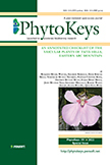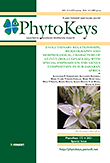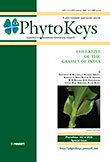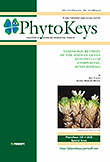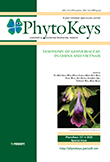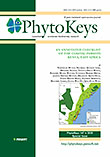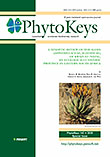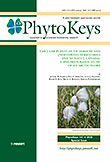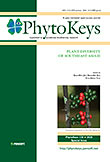Filter
by Year
by Special issues
Go to issue
Issue No
from 1 to 241
from 1 to 241
1-59 issues matching your criteria:
Published
Special Issue
An annotated checklist of the vascular plants of Taita Hills, Eastern Arc Mountain
Benjamin Muema Watuma, Solomon Kipkoech, David Kimutai Melly, Veronicah Mutele Ngumbau, Peninah Cheptoo Rono, Fredrick Munyao Mutie, Elijah Mbadi Mkala, John Mulinge Nzei, Geoffrey Mwachala, Robert Wahiti Gituru, Guang-Wan Hu, Qing-Feng Wang
Papers published: 1
| Total pages: 158
Taxa:
Subject:
Species Inventories (1), Biodiversity & Conservation (1), Floristics & Distribution (1), Taxonomy (1), Catalogues and Checklists (1)
Regions:
Africa (1), East Africa (1)
Printed: € 50,70
Order now
Published
Special Issue
Evolutionary relationships, biogeography and morphological characters of Glinus (Molluginaceae), with special emphasis on the genus composition in Sub-Saharan Africa
Alexander P. Sukhorukov, Alexander Sennikov, Marie Claire Veranso-Libalah, Maria Kushunina, Maya V. Nilova, Roger Heath, Alison Heath, Yuri Mazei, Maxim A. Zaika
Papers published: 1
| Total pages: 92
Taxa:
Molluginaceae (1)
Subject:
Biodiversity & Conservation (1), Floristics & Distribution (1), Taxonomy (1), Identification key (1), Molecular systematics (1), Biogeography (1), Phylogeny (1), Evolutionary biology (1), Nomenclature (1)
Printed: € 32,70
Order now
Published
Special Issue
The genus Lycianthes (Solanaceae, Capsiceae) in Mexico and Guatemala
Ellen Dean, Jennifer Poore, Marco Antonio Anguiano-Constante, Michael H. Nee, Hannah Kang, Thomas Starbuck, Annamarie Rodrígues, Matthew Conner
Papers published: 1
| Total pages: 334
Taxa:
Solanaceae (1)
Subject:
Taxonomy (1)
Regions:
Printed: € 104,70
Order now
Published
Special Issue
Checklist of the grasses of India
Elizabeth A. Kellogg, J. Richard Abbott, Kamaljit S. Bawa, Kanchi N. Gandhi, B. R. Kailash, K.N. Ganeshaiah, Uttam Babu Shrestha, Peter Raven
Papers published: 1
| Total pages: 560
Taxa:
Poaceae (1)
Subject:
Regions:
India (1)
Printed: € 182,70
Order now
Published
Special Issue
Taxonomic revision of the Andean genus Xenophyllum (Compositae, Senecioneae)
Joel Calvo, Andrés Moreira-Muñoz
Papers published: 1
| Total pages: 106
Taxa:
Asteraceae (1)
Subject:
Nomenclature (1), Taxonomy (1)
Regions:
South America (1)
Printed: € 38,70
Order now
Published
Special Issue
Taxonomy of Gesneriaceae in China and Vietnam
Edited by Yu-Min Shui, Wen-Hong Chen, Ming-Xun Ren, Fang Wen, Xin Hong, Zhi-Jing Qiu, Yi-Gang Wei and Ming Kang
China and Vietnam are important center of biodiversity worldwide. Gesneriaceae is a family with extraordinary species richness in China and Vietnam. Within the family, there are more than 600 accepted species in China. The species number will considerably surpass 700 species in China and Vietnam. Fu ...
Papers published: 19
| Total pages: 226
Taxa:
Gesneriaceae (18), Angiospermae (1)
Subject:
Floristics & Distribution (2), Biodiversity & Conservation (1), Evolutionary biology (2), Phylogeny (3), Molecular systematics (1), Biogeography (3), Molecular biology (1), Taxonomy (15)
Printed: € 74,70
Order now
Published
Special Issue
XIX International Botanical Congress, Shenzhen: report of the Nomenclature Section, 17th to 21st July 2017
Heather L. Lindon, Helen Hartley, Sandra Knapp, Anna M. Monro, Nicholas J. Turland
Papers published: 1
| Total pages: 276
Subject:
Nomenclature (1)
Printed: € 86,70
Order now
Published
Special Issue
An annotated checklist of the coastal forests of Kenya, East Africa
Veronicah Mutele Ngumbau, Quentin Luke, Mwadime Nyange, Vincent Okelo Wanga, Benjamin Muema Watuma, Yuvenalis Morara Mbuni, Jacinta Ndunge Munyao, Millicent Akinyi Oulo, Elijah Mbandi Mkala, Solomon Kipkoech, Malombe Itambo, Guang-Wan Hu, Qing-Feng Wang
Papers published: 1
| Total pages: 192
Taxa:
Subject:
Regions:
Africa (1)
Printed: € 62,70
Order now
Published
Special Issue
A synoptic review of the aloes (Asphodelaceae, Alooideae) of KwaZulu-Natal, an ecologically diverse province in eastern South Africa
Ronell R. Klopper, Neil R. Crouch, Gideon F. Smith, Abraham E. van Wyk
Papers published: 1
| Total pages: 88
Taxa:
Asphodelaceae (1)
Subject:
Taxonomy (1), Catalogues and Checklists (1), Biodiversity & Conservation (1), Floristics & Distribution (1), Identification key (1)
Regions:
Printed: € 32,70
Order now
Published
Special Issue
Vascular plants of Victoria Island (Northwest Territories and Nunavut, Canada): a specimen-based study of an Arctic flora
Jeffery M. Saarela, Paul C. Sokoloff, Lynn J. Gillespie, Roger D. Bull, Bruce A. Bennett, Serguei Ponomarenko
Papers published: 1
| Total pages: 330
Taxa:
Subject:
Identification key (1), Biogeography (1), Catalogues and Checklists (1), Biodiversity & Conservation (1), Floristics & Distribution (1)
Regions:
Printed: € 104,70
Order now
Published
Special Issue
Plant diversity of Southeast Asia-II
Edited by Jin X-H, Xia N-H, Tan Y-H
The special issue of plant diversity in Southeast Asia will focus on the documentation of new discoveries in SE Asia. There are four global biodiversity hotspots in Southeast Asia. Although there are many plans to protect this rich biodiversity, however, the rich biodiversity in SE Asia is under thr ...
Papers published: 18
| Total pages: 240
Taxa:
Equisetales (1), Annonaceae (1), Zingiberaceae (3), Asteraceae (2), Equisetaceae (1), Orchidaceae (3), Bambusoideae (2), Rubiaceae (1), Araceae (1), Lauraceae (1), Begoniaceae (2), Angiospermae (1)
Subject:
Evolutionary biology (1), Phylogeny (1), Taxonomy (17), Palaeontology (1), Biodiversity & Conservation (1), Molecular systematics (1)
Printed: € 74,70
Order now
Published
Special Issue
Scorzonera sensu lato (Asteraceae, Cichorieae) – taxonomic reassessment in the light of new molecular phylogenetic and carpological analyses
Maxim A. Zaika, Norbert Kilian, Katy Jones, Anastasiya A. Krinitsina, Maya V. Nilova, Anna S. Speranskaya, Alexander P. Sukhorukov
Papers published: 1
| Total pages: 86
Taxa:
Asteraceae (1)
Subject:
Regions:
Printed: € 32,70
Order now
